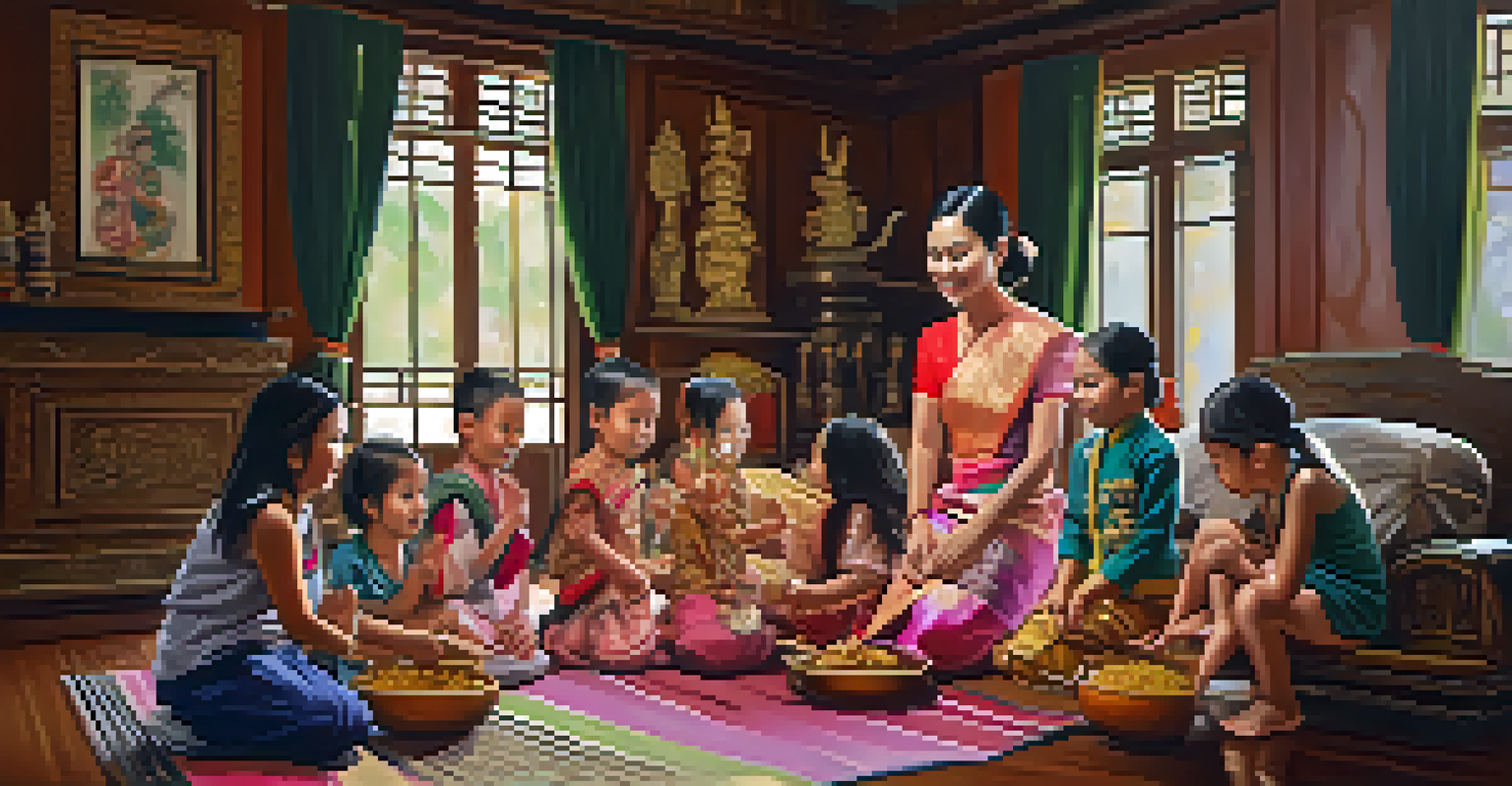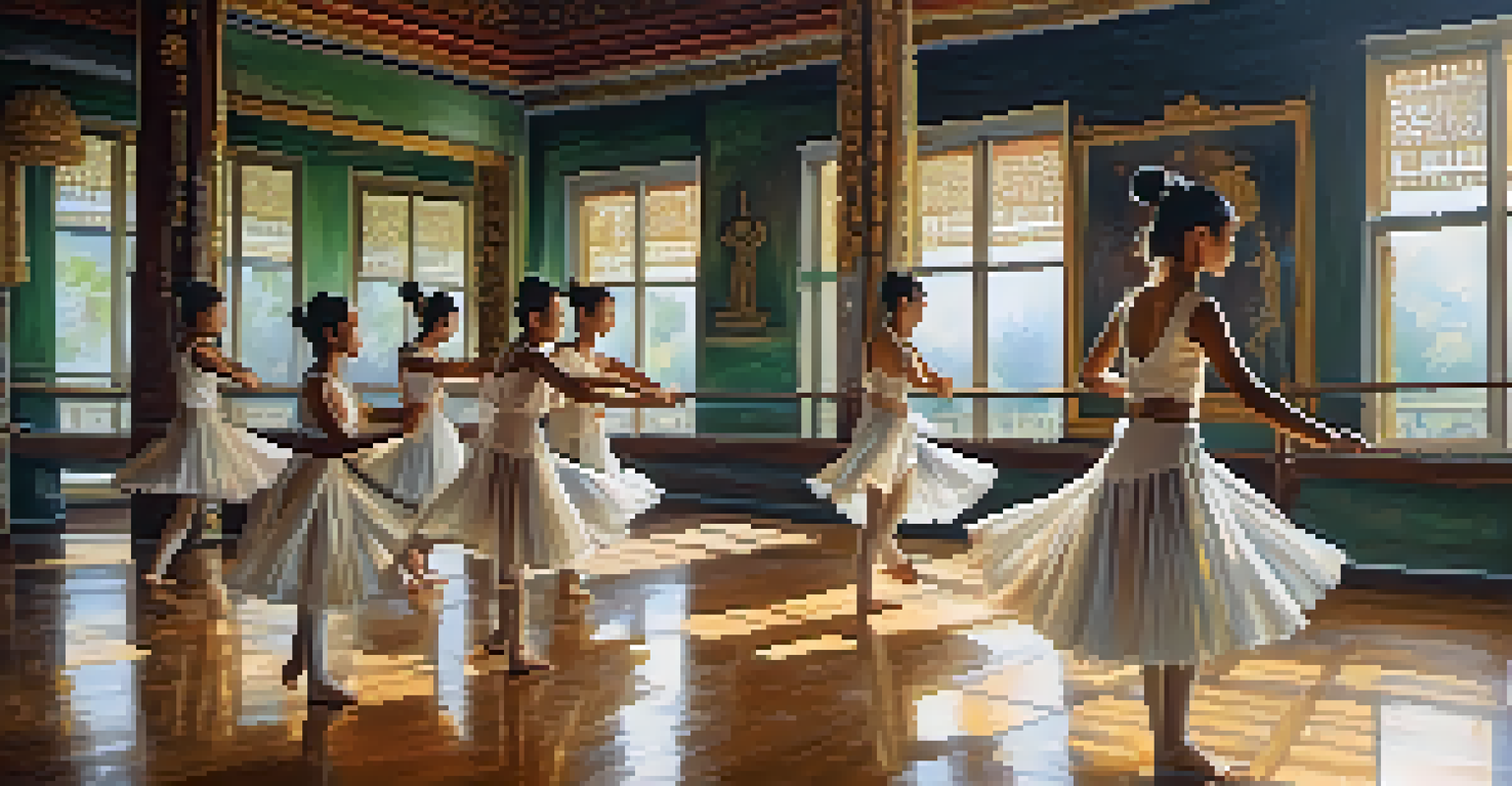How Traditional Thai Dance Is Passed Down Through Generations

The Rich History of Thai Dance and Its Significance
Traditional Thai dance has deep roots in the country’s history, reflecting its cultural heritage. Originating from ancient rituals and court performances, these dances convey stories through intricate movements and expressions. Each performance is not just entertainment; it's a celebration of Thai identity and spirituality, making it a vital part of the nation’s cultural fabric.
Dance is the hidden language of the soul.
As the centuries progressed, various styles emerged, influenced by factors such as religion and royal patronage. These dances serve as a window into Thailand's past, showcasing the traditions, values, and daily life of the people. By understanding the historical context, we can appreciate the depth and complexity of each dance form.
Today, this rich history inspires new generations of dancers, ensuring that the essence of Thai culture remains alive. Each performance is a reminder of the stories and traditions that have shaped Thailand over the years, allowing audiences to connect with the past while looking toward the future.
The Role of Families in Dance Tradition
Family plays a crucial role in passing down traditional Thai dance. Often, it is within the family that children first encounter the art form, learning from parents or grandparents who have practiced it for years. This intimate setting fosters a sense of belonging and pride, as children come to understand their cultural heritage through dance.

In many cases, families will hold informal gatherings where dance is practiced and celebrated. These moments create a strong bond among family members while instilling a love for the art. When children witness their elders performing, it sparks curiosity and admiration, motivating them to continue the tradition.
Tradition Passed Through Families
Family gatherings and mentorship are crucial for passing down traditional Thai dance, fostering pride and connection to cultural heritage.
Moreover, families often take part in local festivals and community events, where they showcase their dance skills. This not only reinforces the family’s connection to the art but also helps keep the community engaged in preserving their cultural traditions.
Formal Training and Dance Schools in Thailand
While family traditions are vital, formal training in dance schools also plays a significant role in preserving Thai dance. These institutions offer structured programs that teach students the technical aspects of various dance forms. Students learn about the history, choreography, and symbolism behind each movement, ensuring a comprehensive understanding of the art.
Tradition is not the worship of ashes, but the preservation of fire.
Renowned dance schools like the College of Dramatic Arts in Bangkok provide professional training, attracting talented individuals who aspire to become proficient dancers. Here, students work under the guidance of experienced instructors who not only teach techniques but also instill a sense of respect for the art and its traditions.
Graduates from these schools often go on to perform in prestigious events, showcasing their skills both nationally and internationally. This exposure helps keep traditional Thai dance relevant and appreciated in a modern context, ensuring its continued evolution while respecting its roots.
Mentorship: Bridging Generations in Dance
Mentorship is a key aspect of how traditional Thai dance is passed down. Experienced dancers often take younger performers under their wings, sharing their knowledge and insights. This relationship not only helps the mentees refine their skills but also deepens their understanding of the cultural significance behind each dance.
Mentors play an essential role in preserving techniques that might otherwise be lost. Through one-on-one training, they can pass on specific movements, expressions, and even stories that are unique to their experiences. This hands-on approach fosters a sense of continuity and connection between past and present.
Role of Technology in Dance
Technology plays a vital role in preserving traditional Thai dance by enabling global sharing, documentation, and online learning opportunities.
As younger dancers become more skilled, they, in turn, can mentor the next generation. This cycle of learning and teaching ensures that traditional Thai dance remains vibrant and dynamic, adapting to contemporary expressions while honoring its historical roots.
Cultural Festivals and Their Impact on Dance Tradition
Cultural festivals play a significant role in keeping traditional Thai dance alive and thriving. These events serve as platforms for dancers to showcase their skills and share their heritage with the community. Festivals often draw large crowds, creating an atmosphere of celebration and appreciation for the arts.
At these gatherings, both young and seasoned performers come together, fostering a sense of unity and pride in their cultural identity. Participants often learn new techniques and styles from each other, enhancing their skills while reinforcing the importance of collaboration in the dance community.
Moreover, festivals attract tourists and international audiences, helping to raise awareness of Thai culture globally. This exposure not only provides performers with opportunities to share their art but also encourages the younger generation to embrace and continue these traditions.
The Influence of Technology on Dance Preservation
In today's digital age, technology has become an invaluable tool for preserving and promoting traditional Thai dance. Online platforms allow dancers to share performances with a global audience, making the art form more accessible than ever. Social media, in particular, has fostered a vibrant community of dancers who can connect and learn from one another.
Additionally, video recordings of performances serve as a record of techniques, styles, and interpretations. This documentation helps ensure that traditional dances can be studied and practiced, even by those who may not have access to formal training. As a result, the art form can continue to evolve while maintaining its core elements.
Challenges in Modern Context
Traditional Thai dance faces challenges from globalization and modern entertainment, risking the loss of cultural practices and participation.
Furthermore, online tutorials and workshops have emerged, enabling aspiring dancers to learn from experts around the world. This democratization of knowledge empowers individuals to engage with traditional Thai dance, encouraging broader participation and appreciation across diverse communities.
Challenges Facing Traditional Thai Dance Today
Despite its rich history and cultural significance, traditional Thai dance faces several challenges in today's fast-paced world. Globalization and modern entertainment options can overshadow these ancient art forms, leading to a decline in participation and interest. As younger generations gravitate toward contemporary dance styles and digital entertainment, traditional practices may struggle to maintain relevance.
Moreover, the pressures of modern life can make it difficult for families to dedicate time to dance training and practice. With busy schedules and competing interests, the transmission of these traditions may be interrupted, risking the loss of unique techniques and stories that have been passed down for generations.

However, organizations and passionate individuals are working tirelessly to combat these challenges. By promoting the importance of cultural heritage and integrating traditional dance into modern contexts, they strive to keep the art form alive and thriving for future generations.
Looking Ahead: The Future of Thai Dance Traditions
Looking to the future, there is hope for the continued preservation and evolution of traditional Thai dance. By leveraging technology, fostering mentorship, and encouraging community engagement, the art form can adapt while retaining its essence. As more young dancers become involved, they bring fresh perspectives and ideas, ensuring that traditional practices remain dynamic.
Cultural initiatives and educational programs also play a pivotal role in raising awareness and appreciation for traditional dance. By integrating dance into school curriculums and community events, future generations can gain a deeper understanding of their cultural heritage and the significance of dance.
Ultimately, the future of traditional Thai dance lies in the hands of those who cherish and celebrate it. With a shared commitment to preserving and passing down these vibrant traditions, Thai dance will continue to flourish, captivating audiences for years to come.